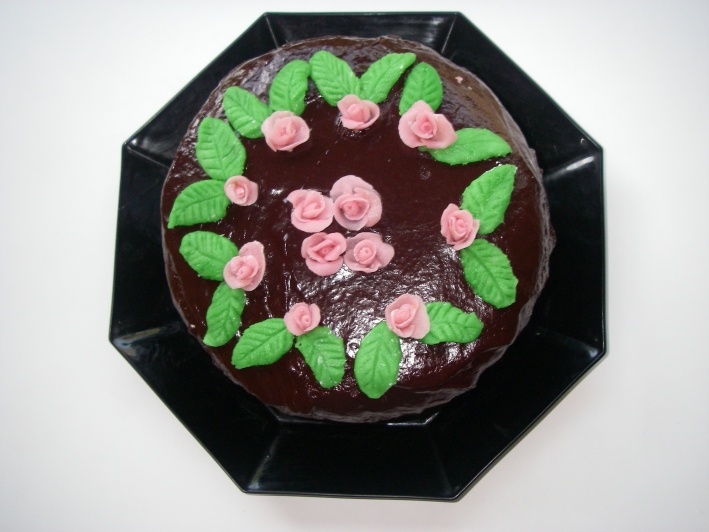Take Two on Sachertorte
Yep, it’s that time of year again. John’s birthday is here.
I’m still broke, so I thought I’d make him another chocolate cake to show off in the office.
Last year, the effort ended in near-disaster, took 6h instead of the advertised 75 minutes but in the end yielded an impressive result (if I may say so myself). I doubt that this year’s effort will look as good, primarily because I’m not using frosted rose petals for decoration (we’re out), but I’ll see what I can do with marzipan and chocolate. At least I now have a camera to record the result for posterity.
The version of Sachertorte I remember eating as a kid always had a layer of marzipan under the chocolate glaze, so this year I’m including it. The recipe loosely follows Orangen Sachertorte, but with considerably less (apricot only) filling and brandy instead of orange liqueur (the local shops aren’t sophisticated enough to have miniatures of Cointreau or Grand Manier for sale).
Chocolate Sponge
Prepare 3 large bowls and a pot of boiling water over which 2 of the bowls fit, plus one smaller bowl. Pre-heat the oven to 170°C. Grease a 20cm ø cake tin, line with greaseproof paper and grease again. Say a prayer.
150g dark chocolate (cocoa >50%); 150 g butter
Melt this in a bowl over steam (the bowl must not touch the water) and cool to room temperature
7 eggs, separated; 1 lot of 130g caster sugar; 1 lot of 50g caster sugar
Separate the eggs next. No matter how many times I do this, when it counts, disaster inevitably strikes. Whisk the whites (with a pinch of salt, if desired) and gradually dissolve the 130g sugar. This mixture should form stiff peaks. If it separates, scoop out the meringue, set aside and add the liquid mess at the bottom to the bowl with the yolk, along with the remaining 50g sugar. (This is what I had to do last year, but I got away with it today).
Place the bowl with the yolks and sugar over the steaming water (it must not touch) and whisk rigorously for 2-3 min. Turn off the heat in between to avoid the yolk turning into custard. Remove from steam and continue to whisk another minute or so, until the mix is pale and fluffy, the colour of home-made mayonaise. This can be done without any heat, but it will take longer.
100g fine flour, sifted; 50g ground almonds
Weigh this out in the remaining bowl.
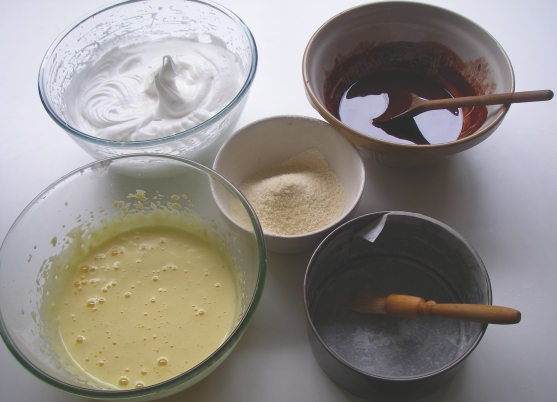
Carefully stir the flour mix into the yolk, then stir in the chocolate. Using a large metal spoon, fold in the meringue (add a large dollop at a time, then cut into the mix and turn over, while turning the bowl). Stir gently to get an even mix and pour into the cake mould.
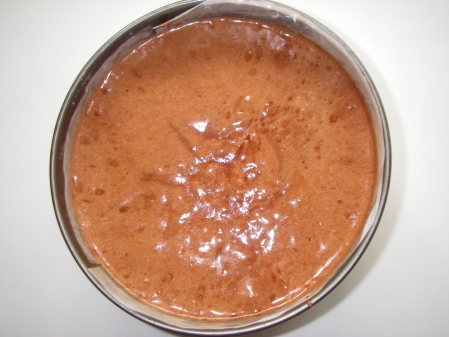
Place on lower base in oven and keep the door ajar by wedging the handle of a wooden spoon into it. Close the door after 10 minutes and bake for about 50 minutes more (test with a skewer). Prepare yet another greased baking sheet on a wooden board on which the sponge can cool.
Cool in the mould upside down for 30 minutes, then turn over and cool completely.

So much for the theory. In keeping with last year, I added a pinch of baking powder to the flour. Don’t do that. Also, the dough will behave like a soufflé and rise considerably, only to sink again.
The final result may be less than impressive, but the covering will hide many sins!
Filling
200g apricot jam; 33cl brandy (miniature bottle)
Melt the jam over gentle heat and pass through a sieve. Stir in the brandy.
Cut the cooled sponge into three slices carefully (I use a carving knife and it still went a bit pear-shaped. Keep calm and let the knife do the work. Uneven slices can always be realigned as the filling won’t be too visible). Spread the slices with the filling, place back together, set cake on a plate and brush the sides and surface ditto.
254g marzipan
Flatten this and place it between two sheets of greaseproof paper. Roll out thinly, removing and replacing the paper towards the end to ensure a smooth finish. Up to this stage, this can be made a few hours in advance.
Peel off the lower layer of paper, place over cake and peel off the outer layer. (Alternatively, dust the rolling pin with icing sugar, lift up sheet by rolling it onto the pin, and place over cake, unrolling again carefully. This is what we learned at the restaurant—flashy, but ultimately pointless.)
Trim and smoothe out any folds. Gravity will pull down the sides of the marzipan. I ended up moulding it a bit with my hands and then having to chill it briefly before it all drooped off!
Transfer the cake to a new plate with a palette knife.
Icing
This is the tricky bit!
150g dark chocolate (around 70% cocoa); 100 ml cream; 2 tbsp strong coffee; 2 tbsp honey; 30g butter
Bring cream, butter, honey and coffee to simmer, take off heat and stir in the chopped chocolate. This should just sufficiently cool and temper the mix. Pour over cake, tilting it and turning the plate to distribute it evenly. Or, if you are me, use a large pallete knife to smoothe it as best as possible.
Transfer the cake to another new plate. Chill for about ½ h, then let set at room temperature and keep your fingers crossed.
The chocolate will still have run, so you could transfer the cake to yet another plate, perhaps with a doily on it, if you are that way inclined. Given the rustic look of my effort, I used a black plate to camouflage the lumpy sides a bit.
Decorations
Marcipan trimmings; red or orange food colour
Keep the trimmings in a ball in clingfilm to prevent drying out.
With a cocktail stick or similar, place small amounts of food colour on the marcipan ball, then knead and roll with the palms of your hand until the colour is evenly distributed. If you want a deeper colour, you can paint the marzipan.
For the roses, make a small cone with a flat bottom and a dent in the top. This is the centre of the bud. Now make tiny, very thin discs, by tapping them between your fingers or on a smooth surface, both dusted generously with icing sugar. It takes a while to get the knack and it won’t work if you have sweaty hands. Fold these around the cone, gradually fanning them out more and more at the top. If they are too dry, use a cocktail stick dipped in a bit of glaze to fasten them and trim off the bottom with a spatula.
This is usually done with satin icing, which is a real pain. Marzipan gives less elegant, but tastier results.
Here are the stages in construcing a rose:
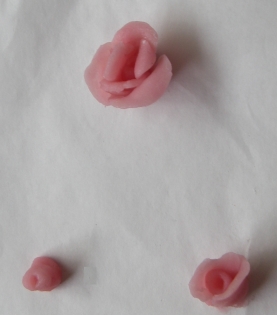
All that’s left now is the assembly—and we’re done (for another year)!
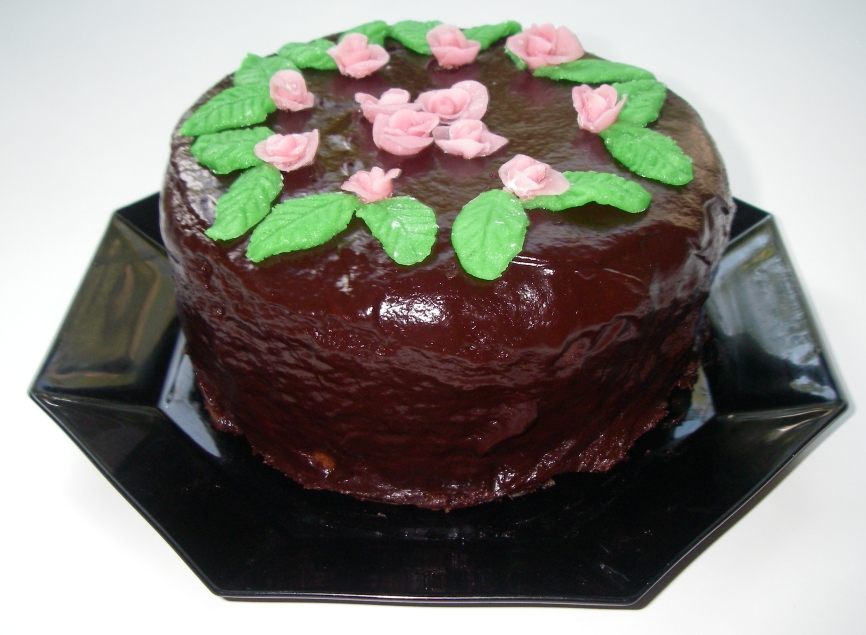
Alright, so the result wasn’t entirely smooth, but if you look carefully at the photo on the original website, you’ll see that the chocolate decorations cover a multitude of sins.
What gets me is just how much waste this patisserie business entails. When I make a roast or a stew, I don’t do so with the intention of chucking half of it away; but everything ended up covered in chocolate, jam and marzipan and after licking the spoon, I could not face any more. So, a lot of the sweet stuff went right into the bin. Offering it to John won’t do—it would spoil the enjoyment of the cake.
The biggest problem is, of course, that I couldn’t taste the thing once it was assembled, but I’m sure it will be fine. Although probably cloying. And as predicted, this took an entire day (from ten to six) because I had to hunt down tips and wasted ages on the rose decorations.
Tags: 'Round the World Recipes, Tag Index
